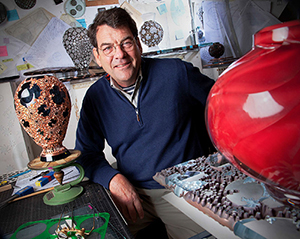AACG News

In Memoriam: Michael Glancy
 Artist and fine art educator Michael McCoy Glancy, who pioneered the use of glass and metal in sculpture, died at age 70 at his summer home in Harwich Port, MA, on Saturday, August 29 after a hard-fought battle with lung cancer. Born February 11, 1950, in Detroit, MI, Glancy traveled a circuitous route to discover the world of studio glass. As a business student at the University of Denver in the early 1970s, Glancy found respite taking art elective courses in ceramics and filmmaking. During a contentious meeting with the dean of the business school, the dean told Glancy that in order to complete his degree he would need to “shave his beard and cut his hair.” Glancy transferred to the art department after that meeting, earning a BFA in 1973.
Artist and fine art educator Michael McCoy Glancy, who pioneered the use of glass and metal in sculpture, died at age 70 at his summer home in Harwich Port, MA, on Saturday, August 29 after a hard-fought battle with lung cancer. Born February 11, 1950, in Detroit, MI, Glancy traveled a circuitous route to discover the world of studio glass. As a business student at the University of Denver in the early 1970s, Glancy found respite taking art elective courses in ceramics and filmmaking. During a contentious meeting with the dean of the business school, the dean told Glancy that in order to complete his degree he would need to “shave his beard and cut his hair.” Glancy transferred to the art department after that meeting, earning a BFA in 1973.
While at the University of Denver, a chance encounter with a glassblowing “hot shop” in Santa Fe, NM, kindled his attraction to the “smoke and fire” of working in glass. Soon after, Glancy built a hot shop of his own through the Denver Free University, offering classes as a self-taught instructor. While living in Colorado, Glancy first met glass artist Dale Chihuly at the Taos Pueblo in New Mexico, and Chihuly encouraged him to pursue a degree in glass at the Rhode Island School of Design (RISD) in Providence. Glancy completed his MFA at RISD under Chihuly’s mentorship in 1980, graduating with fellow glass sculptor Howard Ben Tre. At RISD, Glancy pried open the door to a small, neglected laboratory room in the jewelry and metalsmithing department, ultimately resurrecting electroforming (the application of precious metals through an electrically conducted anode and cathode reaction) at the school. Electroforming became a signature feature of his artwork, and he taught the practice at RISD as adjunct faculty for nearly 40 years.
Glancy’s work as an artist working in deeply engraved and sand-blasted blown glass and electroformed copper, silver and gold - and later in cast bronze and stainless-steel - takes on a simultaneously cosmic quality while being grounded with a microscopic glimpse into the natural world. Tina Oldknow, former curator at the Corning Museum of Glass, wrote: “Michael Glancy’s work is aesthetic, it is scientific, and it might be considered as growing, literally by hand, from a near-molecular vision. Beginning with cell-like patterns and arcane notations jotted on paper, Michael‘s objects slowly acquire form and texture, shaped and revealed by cutting, sandblasting, and the application of copper. New forms are then made from existing forms, and the evolution continues.”
With a career as an exhibiting artist that spanned four decades, Glancy mounted exhibitions with numerous galleries worldwide, including long-standing representation by Barry Friedman Ltd. and the Heller Gallery in New York City, Habatat Galleries in Royal Oak, MI, Galerie von Bartha in Basel, Switzerland, and the Clara Scremini Gallery in Paris. Glancy’s work appears in major museum collections in global cities, including the Metropolitan Museum of Art, the Museum of Fine Arts, Boston, the Smithsonian American Art Museum Renwick Gallery, the Detroit Institute of Arts, the Los Angeles County Museum of Art, Musée des Arts Décoratifs Palais du Louvre, the Victoria and Albert Museum, and the Hokkaido Museum of Modern Art. His work also features prominently at the Corning Museum of Glass, the preeminent collection of studio glass in the Americas. Multiple retrospective books and catalogs on his body of work have also been published, including “Michael Glancy: Infinite Obsessions.”
Glancy took great joy and inspiration in collaborating with the master craftspeople who helped his work evolve through innovation in design, material, and technique. His blown-glass forms were born through a career-long collaboration with master glassblower Jan-Erik Ritzman in the village of Transjö in the “glass kingdom” of southern Sweden, and the bronze and stainless-steel lost wax cast metal forms were poured at the storied Polich Tallix Fine Art Foundry (now UAP) in Rock Tavern, NY. Myles Baer, of Attleboro, MA, Glancy's current and longest serving studio assistant of more than two decades, has become one of the foremost engravers and polishers of glass through mastery of the German Kurt Merker diamond engraving lathe.
Despite a life of travel, discovery, and collaboration, Glancy could be a recluse, choosing to work from a converted colonial barn on a wooded property in Rehoboth, MA throughout his career. An avid sailor of his wooden Beetle Cat “Moss,” a mercurial four-season gardener with his wife, Robin Stengel Glancy, at their home that shared the property with his studio, and an admirer of a fine bourbon, Michael Glancy found his muse in the world and those around him. In addition to Robin, his wife of 42 years, Glancy is survived by his son, Michael McCoy Glancy, Jr. and his daughter-in-law, Elizabeth Little Glancy of Baltimore, MD, their two daughters (Michael’s beloved granddaughters) Ella and Mae, and his son Robin Peyton Glancy of Washington, D.C. Messages of condolence can be sent to the Glancy family through his website: michaelglancyglassworks.com/contact.
| Posted 20 Sep 02





